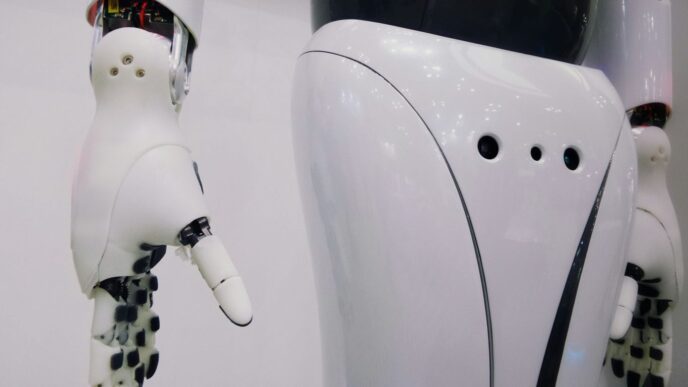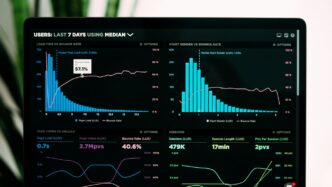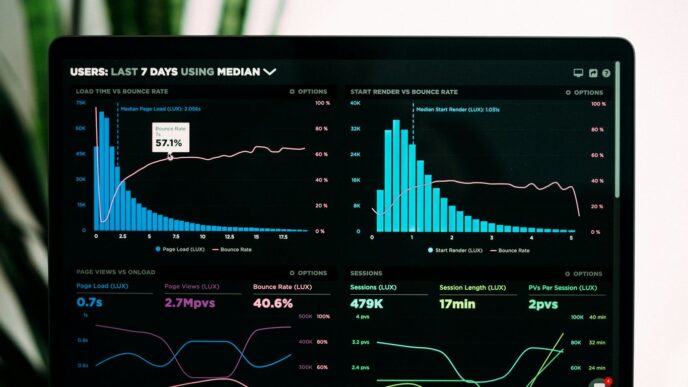California is a big player in the tech world, especially when it comes to artificial intelligence. You know, places like Silicon Valley are right here, and that’s where a lot of the big AI companies hang out. Think OpenAI, Google, Meta, and others. These companies are doing amazing things with AI, making all sorts of new tools and programs. But, with all this new tech comes some pretty serious questions. We’re talking about ethical stuff, legal issues, how it affects society, and even the economy. Because of all this, California has been really active in thinking about these problems and trying to figure out how to manage AI. Lawmakers here have been working with tech companies, universities, the entertainment industry, and other groups. They want to make sure AI is built and used in a good way. The goal is to find a balance: keep innovation going strong, but also protect people and workers. This article will look at what California is doing with AI rules in 2025.
Key Takeaways
- California has been really active in making rules for AI, trying to balance new ideas with keeping people safe.
- Different state groups, like the California Department of Technology and the California Privacy Protection Agency, help watch over AI use.
- New rules focus on being open about how AI works and protecting people’s digital images and information.
- AI rules in California affect many areas, like movies, self-driving cars, and healthcare.
- Companies that make or use AI in California have to follow rules about protecting customers and civil rights, plus new AI laws.
California’s Proactive Stance on AI Regulation
California is really trying to get ahead of the curve when it comes to AI. Unlike some other states that are waiting to see what happens, California is actively creating laws and regulations to manage AI’s impact. It’s a big deal because California is a tech hub, and what happens here could influence how the rest of the country—even the world—deals with AI. California has adopted a proactive approach to regulating AI, distinguishing itself from other states and the federal government.
A Comprehensive Regulatory Landscape
California’s approach isn’t just one or two laws; it’s a whole bunch. As of the start of 2025, there are 18 new AI laws in effect. These laws cover a lot of ground, from making sure AI systems are transparent to protecting people’s privacy. The California AI Transparency Act is a good example, requiring companies to disclose details about their AI systems. It’s like they’re building a safety net around AI to catch any potential problems before they cause real harm.
Balancing Innovation and Public Safety
One of the biggest challenges is figuring out how to regulate AI without stopping innovation. California wants to make sure AI is used responsibly, but they also don’t want to stifle the growth of AI companies. It’s a tough balancing act. They’re trying to create rules that protect people and promote innovation at the same time. This involves working with tech companies, researchers, and other groups to find the right approach. It’s not easy, and there are definitely disagreements about the best way forward.
Lessons from Vetoed Legislation
Not everything goes smoothly, though. The Governor recently vetoed an AI bill that some people thought could be a model for national legislation. The bill had some support, but also a lot of opposition. Some people thought it was too strict and could hurt California’s AI industry. Others felt it didn’t go far enough to address the risks of AI. The veto shows how complicated it is to regulate AI, even in a state that’s generally supportive of regulation. It’s a reminder that there’s no easy answer, and that finding the right balance will take time and effort.
Key Regulatory Bodies Overseeing California AI Regulation

California is really trying to get a handle on AI, and a few key groups are leading the charge. It’s not just about making laws; it’s about making sure they’re followed and that people’s rights are protected. Here’s a quick look at who’s doing what.
California Department of Technology’s Role
This department is like the state’s tech watchdog. They’re responsible for making sure any AI tech used by the state meets certain safety and ethical standards. Think of it as quality control for AI. They want to make sure the AI systems the state uses are fair, reliable, and don’t cause any unintended harm. It’s a big job, especially with how fast AI is changing. They also help other state agencies understand and use AI responsibly. The department also has to keep up with AI chip exports and how that affects California’s tech landscape.
California Privacy Protection Agency’s Enforcement
Privacy is a huge deal, and this agency is all about protecting it. They’re the ones who make sure AI systems follow the California Consumer Privacy Act (CCPA) and other privacy rules. If an AI system is collecting or using your data in a way that’s not allowed, this agency is supposed to step in. They can investigate companies, issue fines, and even take them to court if they’re not following the rules. It’s all about making sure your data is safe and that you have control over it.
California Civil Rights Department’s Focus
This department is focused on making sure AI doesn’t discriminate. They look at things like algorithmic bias, where AI systems might treat people unfairly based on their race, gender, or other characteristics. They enforce civil rights laws like the Fair Employment and Housing Act and Title VII of the Civil Rights Act to ensure AI systems don’t violate anyone’s rights. It’s a tough job because bias can be hidden in the data that AI systems use, but they’re working to make sure AI is fair for everyone. They’re also working on AI transparency so people can understand how these systems work and challenge them if they think they’re being treated unfairly.
Current Framework and Guidelines for California AI Regulation
So, what’s the deal with how California is actually regulating AI right now? It’s a bit of a mix, honestly. There are some key laws and guidelines that are starting to shape things up, but it’s still evolving. Think of it as a work in progress, with the state trying to figure out how to keep up with this crazy fast technology.
Transparency and Disclosure Requirements
The California AI Transparency Act (SB 942) is a big one. It basically says that if you’re running a large generative AI system, you need to be upfront about it. This includes letting people know they’re interacting with AI and providing a way to detect AI-generated content. Plus, there are penalties if you don’t comply. It’s all about making sure people aren’t being tricked or misled by AI. This is a big step towards internal transparency audits.
Protecting Digital Likenesses and Data
California is also serious about protecting people’s digital identities. There are laws (AB 1836 and AB 2602) that prevent the unauthorized use of someone’s voice or likeness, even if it’s AI-generated. This is especially important in the entertainment industry, where digital replicas could easily be misused. And starting next year, the Generative AI Training Data Transparency Act (AB 2013) will require AI developers to post summaries of their training data. It’s all about knowing where this stuff comes from and how it’s being used. This is important for AI in healthcare.
Standardizing AI Definitions Across Laws
One of the challenges with regulating AI is that everyone has a different idea of what it actually is. That’s why California passed AB 2885, which aims to standardize the definition of AI across all state laws. This makes it easier to enforce regulations and ensures that everyone is on the same page. It’s a small thing, but it makes a big difference in terms of clarity and consistency. This helps with AI regulation.
Impact of California AI Regulation on Specific Sectors
California’s been pretty focused on making sure AI regulations actually address the real-world needs of different industries here, and the specific problems they’re facing. It’s not a one-size-fits-all approach, which makes sense, right?
Entertainment Industry Safeguards
Okay, so California’s got this AI digital replica legislation, specifically Assembly Bill 2602, and it’s a big deal for Hollywood. Basically, it puts some serious rules in place about using digital versions of performers. You need explicit permission to use an actor’s digital likeness, which is all about protecting their rights and intellectual property. The entertainment industry is huge here, bringing in billions, so keeping it safe is important for the economy and for artists’ creative freedom. This bill is a proactive way to deal with the legal and ethical mess that AI tech can create.
Advancements in Automated Vehicles
California’s always been a testing ground for self-driving cars, and the new AI regulations are adding another layer to that. The state’s making sure that these vehicles are safe and reliable, which means things like:
- Mandatory testing and reporting requirements.
- Strict data privacy rules to protect passenger info.
- Ongoing monitoring of AI systems to catch any issues early.
It’s a tricky balance, because everyone wants innovation, but nobody wants unsafe AI on the roads. The goal is to create a framework that lets automated vehicle advancements happen responsibly.
AI Utilization in Healthcare
AI is starting to show up in healthcare more and more, and California’s trying to get ahead of the curve with regulations. The focus is on making sure AI tools are accurate, fair, and don’t compromise patient privacy. Some key areas include:
- Transparency: Doctors and patients need to know how AI is making decisions.
- Bias detection: Making sure algorithms aren’t biased against certain groups.
- Data security: Protecting sensitive patient data from breaches.
There’s even a specific bill, the AI in healthcare utilization review (SB 1120), that sets standards for AI used by health plans and insurers. It’s all about AI transparency and making sure AI helps, not hurts, people’s health.
Legal Obligations for AI Developers and Users in California
California is really trying to get ahead of the curve when it comes to AI, and that means figuring out who’s responsible for what. It’s not just about making cool new tech; it’s about making sure things are fair and safe for everyone. So, if you’re building or using AI in California, there are some things you absolutely need to know.
Ensuring Consumer Protection
California’s Unfair Competition Law (UCL) is a big deal. It’s there to stop businesses from doing shady stuff, and that includes AI. Think about it: fake ads, deepfakes, using someone’s face without permission – all that falls under the UCL. Basically, if you’re using AI to trick people or do something unfair, you’re going to have a problem. The law is broad, so it covers a lot of ground. You can’t just say, "Oh, the AI did it, not me." You’re on the hook for making sure your AI doesn’t break the law. This is especially important with the rise of new state laws regulating AI.
Adhering to Civil Rights Laws
AI can’t discriminate. Seems obvious, right? But it’s easy for AI to pick up on biases in the data it’s trained on, and then start making unfair decisions. California has laws like the Civil Rights Act and the Fair Employment and Housing Act (FEHA) to prevent discrimination. If your AI is used for hiring, housing, or anything else that affects people’s lives, you need to make sure it’s not biased. And if the AI does make a decision that seems unfair, you need to be able to explain why. No one wants an AI deciding their fate based on some messed-up data.
Compliance with New AI Legislation
Things are changing fast. As of January 1, 2025, there are new rules on the books. Here’s a quick rundown:
- Disclosure: If you’re training AI, you might have to tell people where you got your data. It’s all about being open and honest.
- Likeness: You can’t just use someone’s face or voice in AI-generated content without their okay. That’s a big no-no.
- Elections: AI-generated campaign ads need to be clearly labeled. No trying to trick voters with fake content.
- Healthcare: If you’re using AI in healthcare, a real doctor needs to be in charge. AI is a tool, not a replacement for human expertise.
These new laws are on top of the existing ones, so you need to stay up-to-date. It’s a lot to keep track of, but it’s important to get it right. Otherwise, you could be facing some serious legal trouble.
California AI Regulation and Litigation Trends

Judicial Branch Task Force Initiatives
California’s judicial branch is getting serious about AI. They’ve launched a task force to figure out how AI will impact the courts and legal proceedings. This group is looking at everything from AI-powered legal research tools to the use of AI in evidence analysis. It’s a big deal because the courts want to be ready for the new challenges and opportunities that AI brings. They’re thinking about things like:
- How to handle evidence generated by AI.
- Ensuring fairness and transparency when AI is used in court decisions.
- Training judges and court staff on AI technologies.
Guidance for Lawyers Using Generative AI
Generative AI is changing how lawyers work, but it also brings risks. The California Bar is working on guidelines to help lawyers use these tools responsibly. It’s not just about efficiency; it’s about ethics. Lawyers need to understand the limitations of AI and make sure they’re not relying on it blindly. The guidelines will likely cover things like:
- Verifying the accuracy of AI-generated content.
- Protecting client confidentiality when using AI tools.
- Disclosing the use of AI to clients and the court.
Addressing AI-Related Legal Challenges
AI is creating new kinds of legal problems. From AI in real estate to algorithmic bias, there’s a lot to figure out. California courts are starting to see cases involving AI, and they’re having to grapple with complex issues. Some of the challenges include:
- Determining liability when an AI system makes a mistake.
- Protecting intellectual property rights in AI-generated works.
- Addressing discrimination caused by biased algorithms.
It’s a constantly evolving area, and the legal system is playing catch-up. The goal is to create a framework that protects people while still allowing for innovation. The state is trying to balance consumer protection with the needs of the tech industry, which is no easy task.
The Future Trajectory of California AI Regulation
Continuous Monitoring and Adaptation
California’s approach to AI regulation isn’t a ‘one and done’ deal. It’s more like a continuous feedback loop. The state government is actively watching how AI tech evolves and adjusting the rules as needed. This means keeping an eye on new developments, potential risks, and the overall impact of AI on society and the economy. It’s a bit like patching a tire while driving – constant adjustments to keep things rolling smoothly. The frontier AI report will be essential for future policy considerations.
Fostering Global Cooperation and Standards
California isn’t operating in a bubble. What happens with AI here affects the rest of the world, and vice versa. So, there’s a big push to work with other countries and organizations to create common standards and best practices. This helps ensure that AI systems developed in California can compete globally and that everyone is on the same page when it comes to ethical considerations and safety. Think of it as trying to build a global AI community where everyone speaks the same language.
Addressing Emerging Ethical and Economic Impacts
AI isn’t just about cool tech; it also raises some serious questions about ethics and the economy. What happens when AI takes over jobs? How do we prevent bias in algorithms? These are the kinds of issues California lawmakers are grappling with. They’re looking at ways to mitigate the negative impacts of AI while still promoting innovation and economic growth. It’s a balancing act, trying to make sure that AI benefits everyone, not just a select few. The state is trying to figure out how to handle the economic impact on the workforce.
Wrapping Things Up: What’s Next for California AI Rules?
So, as we look ahead to 2025, it’s pretty clear that California is still figuring out how to handle AI. They’ve already put a bunch of rules in place, which is more than most places. But AI changes so fast, right? So, the folks in charge in California are going to keep watching things closely and probably add more rules down the road. Remember that SB 1047 bill that didn’t pass? That showed everyone that making big, sweeping AI rules is tough. You need everyone on board – government people, big companies, small companies, everyone. California wants to stay a leader in AI, so they need rules that help tech companies, not hold them back. They also need to make sure the rules are fair for everyone, no matter how big or small the company is. Lawmakers will keep looking at things like fairness, privacy, security, and how AI affects jobs. They’ll also check out what other countries are doing with AI rules. Having similar rules around the world helps everyone work together and keeps things fair for California companies in the global market.
Frequently Asked Questions
Why is California so focused on AI rules?
California is taking the lead in creating rules for AI. They want to make sure AI is used in a good way, helping people and not causing harm. They’re working with tech companies and other groups to find a good balance between new ideas and keeping people safe.
What kind of AI laws does California have?
California has passed many new laws about AI, especially starting in 2025. These laws cover things like fake videos (deepfakes), keeping your personal information private, how AI is used in hospitals, and making sure AI is fair and clear.
Who is in charge of enforcing these AI rules?
Several important groups in California are in charge of AI rules. The California Department of Technology makes sure AI is safe and ethical. The California Privacy Protection Agency checks that AI follows privacy laws. And the California Civil Rights Department works to prevent AI from being unfair to anyone.
Do these AI rules apply to different types of businesses?
Yes, California’s rules affect many different areas. For example, in Hollywood, there are rules about using actors’ digital images and voices without their permission. In self-driving cars, there are rules to make sure they are safe. And in healthcare, there are rules about how AI handles your health information.
What do AI makers and users need to do to follow the rules?
If you make or use AI in California, you need to follow several rules. You must be clear about how you use AI and how you handle people’s information. You also need to make sure your AI doesn’t treat people unfairly. New laws starting in 2025 will also require you to share information about how your AI was trained.
What’s next for AI rules in California?
California is always watching how AI changes and will update its rules as needed. They also want to work with other places around the world to create similar rules. This helps make sure AI is used safely and fairly everywhere, and that California’s tech companies can still compete globally.














